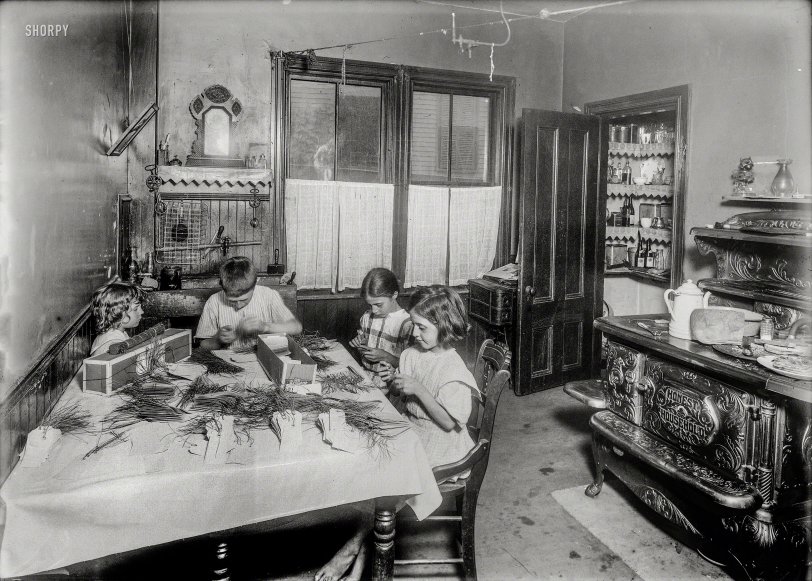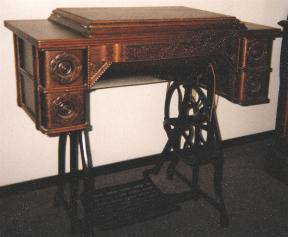


Framed or unframed, desk size to sofa size, printed by us in Arizona and Alabama since 2007. Explore now.
Shorpy is funded by you. Patreon contributors get an ad-free experience.
Learn more.

- Lofty addition
- In 1912
- Keenan Building
- Six years old
- Taken from the P.J. McArdle Roadway?
- It stood only 47 years
- Three track mind
- Incline to the right
- Reach for the sky, 1912 style
- No clean sweep
- Same Job Title, Same Face
- Sadly Lost
- Beautiful ...
- Where you get your kicks
- Aim High
- Pueblo Revival sisters
- Pueblo Neoclassicism
- Milk Man
- Regional dialect.
- Spielberg's inspiration
- Great Photo
- Loaf Story
- Do you still have the Rakes category?
- Could almost be a scene from the 1957 movie 'Hell Drivers'
- The Wages of Fear.
- Conspicuous by their absence
- Got Milk?
- All that aluminum
- No lefties
- Smoke 'em if you've got 'em
Print Emporium
Honest Household: 1912

August 1912. Roxbury, Mass. "Home work on tags. Home of Martin Gibbons, 268 Centre Street. James 11, years old; Helen, 9 years; and Mary, 6, work on tags. Helen said she could tie the most (5,000 a day at 30 cents). Mary does some but can do only 1,000 a day. They work nights a good deal. The night before, Helen and James worked until 11 p.m." Photo by Lewis Wickes Hine. View full size.
a stitch in time ?
the cabinet behind the door with the drawers, hinged top and iron frame seems very similar to the Singer sewing machine my mother had, perhaps a little seamstressing helped fill in the gaps in the family finances ? or maybe just kept things in repair.

Couldn't Help but do some Digging
I spent a half hour or so doing some research and found a bit of information on the family.
I found the family in the 1910 Census, living at the same address.
Martin and Mary were Irish immigrants, married for about 18 years at the time of this photograph. Martin's occupation is a stablehand at the city stables.
The curly headed child to the left watching on would be Martin, Jr, aged 4 at the time of this photo.
Not listed is an older sibling, John (16 at the time, so probably employed elsewhere).
Jumping back to 1900 shows them still renting from the same address, only with Martin's grown sisters Norah and Ellen living with the young couple.
Jumping ahead to 1920 shows Mary as now being widowed, still renting at the same location, with the addition of children Thomas (age 9) and Josephine (age 4) living with her. Mary is now employed as a cleaner at a shoe factory, James is a "Moving Picture Operator" at a local theater, and Helen is a clerk at a shoe factory.
The family aged out and moved on (or simply dropped from any easy way to locate them) after 1926 - the last time I could locate them (still living at 268 Centre).
As an aside, I found Martin in Google Books under employees of the city of Boston - apparently he had been working for the city since 1897, and as of the 1908 listing where I found him, his wages were $2.25... a day. I also found his death record on February 28, 1915 (which means Josephnie was probably born after he passed). He was still working in the city stables at the time.
I found the Gibbons' Find - A - Grave listing as well. Mary lived another 50 years before passing in 1965. Her children Joseph and Mary preceeded her in 1920 and 1952 respectively.
http://www.findagrave.com/cgi-bin/fg.cgi?page=pv&GRid=37957776&PIpi=1835...
Industrious Souls
Seeing these obedient young kids doing this very tedious work does tug at the heartstrings, but one must remember that in 1912, struggling families had to make use of everyone's labor to earn a few extra cents here and there. My mom, born in 1910, strung beads for a jewelry co. when she was 13. In the very early 1950's, she worked in a paper mill, manufacturing and wrapping toilet paper, and there was a time when she brought work home for my 3 sibs and I in which we had to stamp (with rubber stamps and ink pads) the correct number of 'sheets' on each paper wrapper as they did lots of private labels for generic paper and had to show the correct number of sheets within, which varied with different companies. It was such a wretched, boring job which yielded just coinage (for stamping thousands of wrappers), but one kid had to flip the wrappers while another had to do the stamping and since there were 4 of us, we'd change jobs. We all had carpal tunnel syndrome and Popeye arms within a few months, but we're okay now. It does keep one humble forever after.
What are they doing?
They're stringing the tags, I guess for Dennison since that's whose label is on the box. (Later Avery-Dennison, makers of Avery labels). Printing and cutting the tags could be done mechanically, but putting the strings (or wires, depending on use) thru the holes and tying them was hand work for years, and it may be still for all I know. The tags would be filled in by the end user.
Cottage Industry
These children are working at home, certainly, perhaps for their parents' employer. But I'm not so sure what they are really doing. Are they just attaching the tags to the string or wire by which thy are later to be affixed to something for sale? Or are they also filling in labels? I don't see pens or ink so I suspect the former. Certainly there isn't merchandise in this room that is destined to receive the tags.
So, it's a classic problem in mass production, reducing the work to small pieces to be performed repeatedly till the worker gets carpal tunnel syndrome and needs to retire.
Classic shaker
It looks like there is a quilted pattern salt shaker on stove just like the one I have in my cupboard. I had no idea that pattern went back that far!

Is that a mirror?
I wonder if that's a mirror hanging from the wall and ceiling on the far left, slanted downward towards the sink area? If so, my best guess is that it reflects some of the scant light in the room towards the sink. It's probably hard to make sure your dishes are clean if you're washing them in the dark.
Respectable children
Even though this family is very poor, their home is clean and orderly. The children are nicely dressed and look healthy. The girl on the right is barefoot and possibly the rest of the other children are also. As with all of Hines photographs, one wishes these children had it easier as their lives went on.
Primitive times
Gas light above, oil lamp on shelf. No sign of electricity. This is one of the best photos I've seen of how a typical kitchen looked before all the modern things we take for granted now. I'm glad I was born 34 years later when life was easier. It's really amazing how quickly technology advanced in the twentieth century.
























On Shorpy:
Today’s Top 5